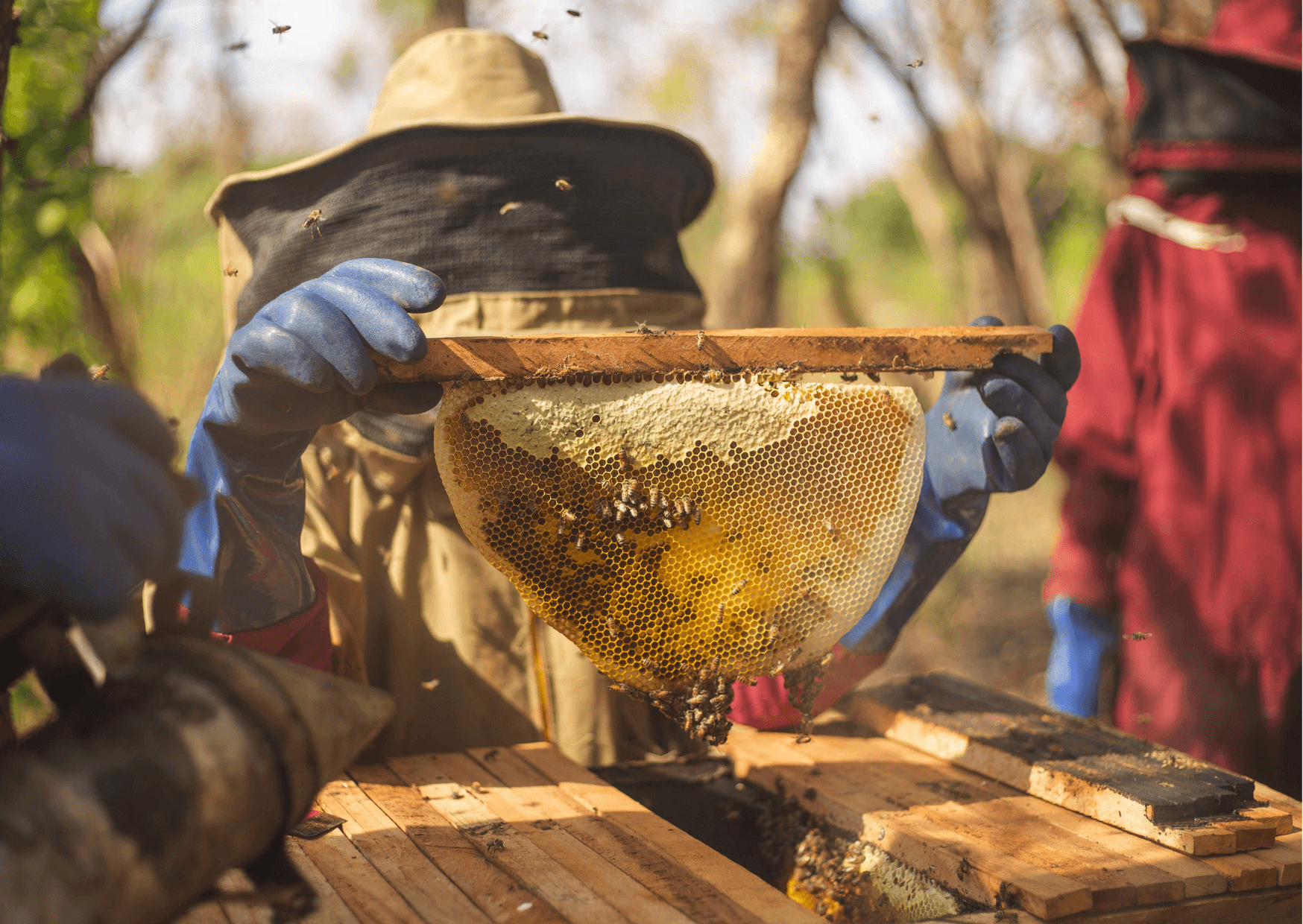Jun 23, 2024
Report written by Natale Alexander with input from Severina Makana and Natale Baiki. Minor edits by Christine Ratcliffe
To find out about how this project came about, see our blog ‘Supporting Beekeepers in South Sudan‘
Getting from South Sudan to Kasese, Uganda
This training in beekeeping for three of us from Namatina Payam – South Sudan namely: Natale Ukele Alexander, Severina Mark Makana and Natale Adriano Baiki has been sponsored by Bees Abroad through Richard Ridler who organized all the programs for this training including our transport from South Sudan to Kasese-Uganda and back to South Sudan, our training, accommodation, feeding etc.
We left Juba for Kampala at 7:30 AM on Tuesday 14/05/2024 till we reached Kampala at 12.00 AM after over twenty hours travelling. The following day we reached Kasese at 5:00 PM after around ten hours travelling where we met with Daniel from LIDEFO, the local partner for Bees Abroad, who was waiting for us.

Training with Bees Abroad’s local partner, LIDEFO – the theory
On the first day, we learnt about beekeeping and the Training of Trainers (TOT). For the first three days, we did theory, and they could show us various pictures of beehives like:
Traditional beehives
Kenya Top Bar (KTB). He brought this practically in the classroom
Langstroth
Catcher Box
We learnt about assessing environment for beekeeping, products of bees, types of bees like the queen, workers and drones and training methods and applications and that there are three types of farmers (beekeepers).
We also learnt about the development of the larva into bees and new terminologies like: Bee colony, apiary, swarming, absconding, propolis, pollen and pollination.We also learnt about apiary site selection, apiary establishment, apiary management and forage management, beehive inspection, inspection for what and bee sting management.
It took us two full days to master beehive making as it included: Timber selection, iron sheets, nails, carpentry tools, measurement, cutting the timber, nailing the timer into hive, making top bar and foundation bar and the cover.

Training with Bees Abroad’s local partner, LIDEFO – practical sessions
We went to two various apiaries which are located 40 KM from Kasese where we were give the bee suits, gum boots and gloves to wear for the first time in our lives and hive tools each plus smokers to use.
We practically each smoked the beehives through their entrance and on every side and we removed the cover of beehives for inspections, harvesting the honey, we saw workers, queen and drones, matured and unmatured combs, broody and no bee stung anybody except Daniel who was stung at the first apiary and Severina at the second apiary because they did not close their zips well.
Practical work at the apiary was more enjoyable than theory as we participated physically and could use the hive tools for opening or removing top bars to see which combs were matured or not matured. We came back to our hotel at 7:00 PM and we were tired and during our supper three of us agreed that we have done good work for the day and we thank Bees Abroad and our tutors for training us.

Reflections on the training
The twenty years Daniel has spent at LIDEFO plus others like Mbusa Moses and Simon have made them very good teachers in the field of beekeeping.
The perception we came with about beekeeping started to change just during theory before we started to make beehives, went to the fields and do everything practical.What we enjoyed much were:
The theory
Making beehives
Practical visit and various activities at the apiaries
All the activities at the processing plant.
Then, we were given: Certificate of attendance in Beekeeping, 6 Bee Suits, 6 Gum boots, 6 Pairs of gloves, 6 Hive tools, 6 Smokers, 4 Learning/Training manuals.
When we were at our hotel the questions, we asked ourselves with were:
What did LIDEFO do to reach such a level in beekeeping industry?
What can we do to be like LIDEFO?
What shall do to enable our community members understand and reach the stage of LIDEFO?
Since we do not have timber stores in Namatina Payam, how shall we get timber for making beehives for our people to see it practically?
How shall we teach our people only with theory without practical?
We agreed that we should be committed despite difficulties we shall encounter in the fields.
On the last day we sat down for evaluation together with our tutors at LIDEFO, three of us came up with this proposal if Bees Abroad could support beekeeping to be successful in Namatina Payam.
Taking the training back to the remote community in South Sudan
Then, Natale Baiki left for our home town, Namatina Payam, which he reached after three days because he had to move from Wau to Namatina on a motorcycle.
That Natale Baiki sits down with the community members under the shades of trees and give them the theory and for practical, he has resorted to drawing the picture of beehive, top bar and foundation bar on the ground in the sand. Explaining the measurement of each side of the hive.
He has shown to them the bee suits, gloves, boots, hive tools, his certificate, training and learning manuals given to us by LIDEFO and they were excited to see all of that and know that people from other parts of the world harvest honey without fire and no bee stings.
They also told Natale that the numbers of bee colony have started to reduce and Natale told them that this is because they keep on burning bees and at the end of some times, they will burn all the bees in Namatina Payam and there will be very low bee colonization.
They were very interested and wanted to learn it practically and some photos shall be sent to Richard at Bees Abroad in due course.
End of the report on training.
NATALE UKELE ALEXANDER & OTHERS







